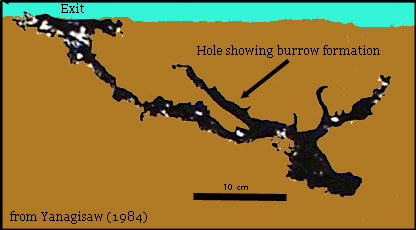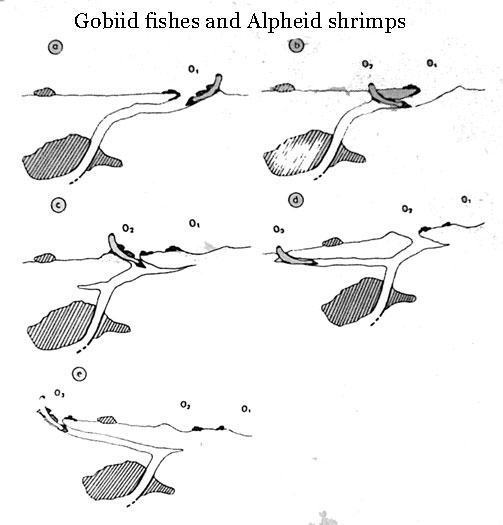





Burrows
The study of burrows, and the dynamics of them is one of more well-known aspects of the shrimp-goby relationship. This bay be because burrows present a somewhat stationary (and often the only visible feature of the symbiosis), they are well documented. A discussion of burrows can be divided, as done by Karplus (1987), into three subjects: Structure of the burrow, Physical construction of the burrow, and Burrow dynamics.
Structure:
The size and shape of a burrow, depends on the species of shrimp and the type of sediment. There are generally three types of burrow construction, seen in the following diagram:

Knowing that shrimp burrows differ depending on shrimp species, it seems logical that one should be able to determine the type of shrimp that constructed a burrow, simply by analyzing some feature or combination of features of the burrow. As it turns out, Cummins (1979), who did an extensive survey of burrows from four shrimp varieties on the Great Barrier Reef could not find any diagnostical feature between shrimp. Other researchers have proposed that the burrow structure is determined mostly by the substrate (Karplus1974; Yanagisawa 1984).

In the past, it was assumed that burrows were realtively short; around 20-10 cm (Luther 1958). But with discovery of epoxy and polyester resins, one can pour them into a hole and then dig them out later. The hole above shows the cast of one of these holes that has been overlayed into a symmulated environment where it would have been poured (Yanagisawa 1984). There are several branching sections to these holes, of which may have been old burrows openings.
Farrow (1971) found that the structure of the sediment is very important in determining the structure of the burrow. When the sediment was rocky, he found the holes were irregular but when the holes were muddy, they were regular and dichotomously branching.
As may be apparent by this point, the actual appearence of a burrow depends on many things like the shrimp and the sediment. Some burrows may be shallow and branching while others are short and deep. There are a few general standards though. First of all, if the shrimp is large, the burrow will be comparatively large (Yanagisawa 1984). Secondly, if the burrow is deep, its usually shorter than a shallow burrow (Cummins 1979). Finally, the actual morphology of a tunnel tube is relatively consistent in all shrimp. The floors will be sandy as the shrimp buldoze sand out and the the tops will be somewhat rocky or filled in with coral pieces to prevent the collapse (Yanagisawa 1984).
Construction
The construction of burrows by shrimp can be studied through aquariums where the shrimp are digging near the glass (personal obervation). In all cases (except one described by Farrow 1971), the shrimp are the sole caretakers of the burrows. Karplus (1987) has summarized the three techniques used by shrimp to maintain the burrow as follows:
- Shrimp using the first pair of large snapping chelae to jab into the sand and then twist till sand collapses.
- Digging with the second pair of chelae, and the third and fourth pair of pereipods.
- Digging with the pleopoda, but only inside the burrow as this action would eliminate the shrimps escape mechanism.
Dyanamics:
The entance of a burrow is not a solid structure like you may imagine a manhole cover or even a fox hole. The burrows these shrimp dig, are built in sandy sediment that if not maintained will collapse in less than an hour (pers obser). In fact, much research has described the daily shifts of burrow entrances over extended periods of time (Magnus 1967; Karplus et al. 1974; Cummins 1979; and Yanagisawa 1982, 1984). The results have shown that for the most part the holes will change daily up to about 40 cm. As a gernal rule, the larger grain the sediment (coarser), the larger the change in goby entrance size (Karplus 1974). Yet, when analyzed over two years, as done by Cummins (1979), he found the holes in nearly exactly the same spot. Thus, while holes may change daily due to the formation of slightly new etrances, the subterrain burrows likely remain the same and change very little (see diagram below).
